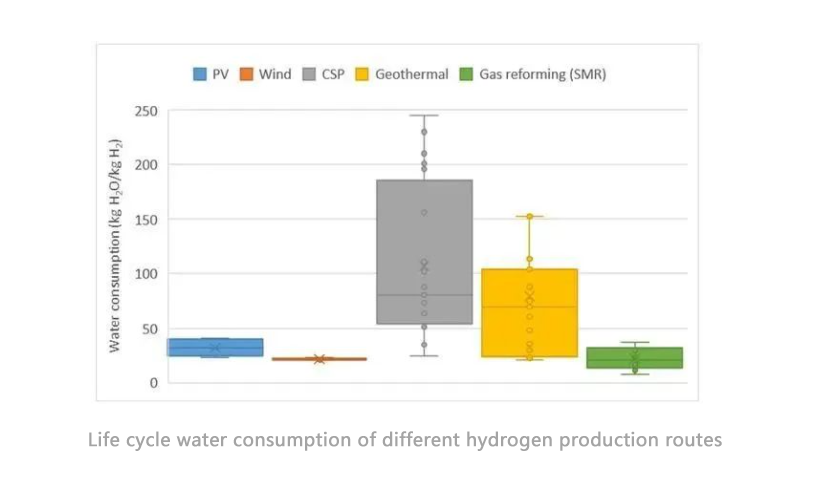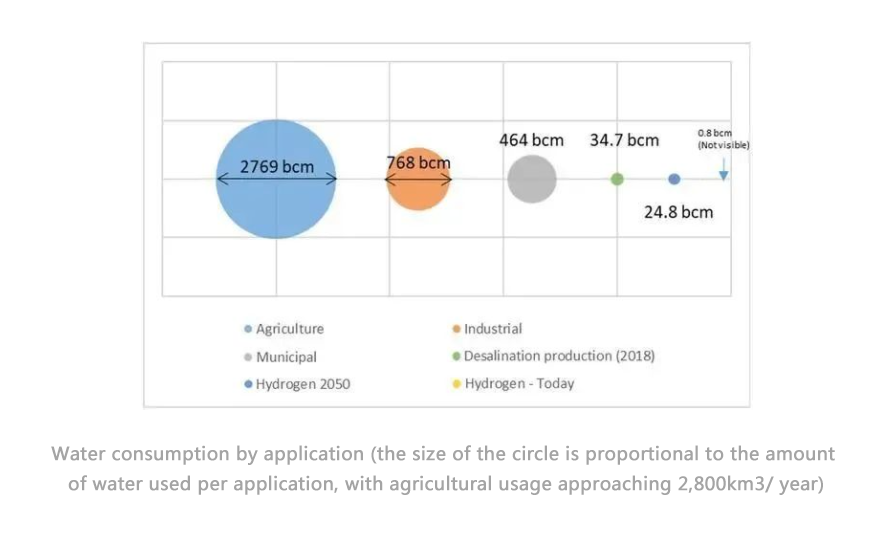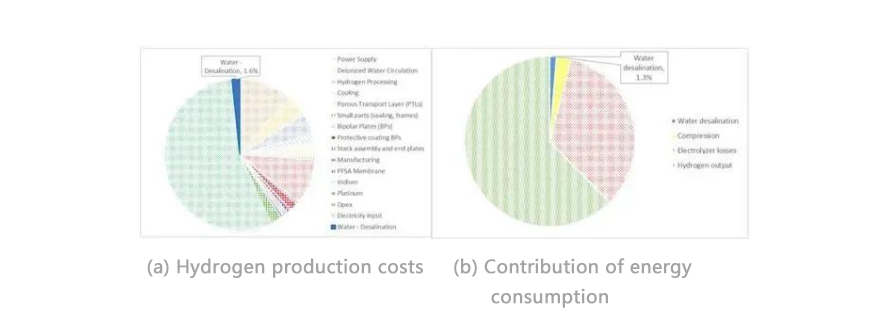- English
- Español
- Português
- русский
- Français
- 日本語
- Deutsch
- tiếng Việt
- Italiano
- Nederlands
- ภาษาไทย
- Polski
- 한국어
- Svenska
- magyar
- Malay
- বাংলা ভাষার
- Dansk
- Suomi
- हिन्दी
- Pilipino
- Türkçe
- Gaeilge
- العربية
- Indonesia
- Norsk
- تمل
- český
- ελληνικά
- український
- Javanese
- فارسی
- தமிழ்
- తెలుగు
- नेपाली
- Burmese
- български
- ລາວ
- Latine
- Қазақша
- Euskal
- Azərbaycan
- Slovenský jazyk
- Македонски
- Lietuvos
- Eesti Keel
- Română
- Slovenski
- मराठी
- Srpski језик
How much water does it take to make hydrogen by electrolysis?
2023-03-08
How much water is consumed by electrolysis
Step one: Hydrogen production
Water consumption comes from two steps: hydrogen production and upstream energy carrier production. For hydrogen production, the minimum consumption of electrolyzed water is approximately 9 kilograms of water per kilogram of hydrogen. However, taking into account the demineralization process of water, this ratio can range from 18 to 24 kilograms of water per kilogram of hydrogen, or even as high as 25.7 to 30.2.
For the existing production process (methane steam reforming), the minimum water consumption is 4.5kgH2O/kgH2 (required for reaction), taking into account process water and cooling, the minimum water consumption is 6.4-32.2kgH2O/kgH2.
Step 2: Energy sources (renewable electricity or natural gas)
Another component is water consumption to produce renewable electricity and natural gas. The water consumption of photovoltaic power varies between 50-400 litres /MWh (2.4-19kgH2O/kgH2) and that of wind power between 5-45 litres /MWh (0.2-2.1kgH2O/kgH2). Similarly, gas production from shale gas (based on US data) can be increased from 1.14kgH2O/kgH2 to 4.9kgH2O/kgH2.

In conclusion, the average total water consumption of hydrogen generated by photovoltaic power generation and wind power generation is about 32 and 22kgH2O/kgH2, respectively. The uncertainties come from solar radiation, lifetime and silicon content. This water consumption is on the same order of magnitude as hydrogen production from natural gas (7.6-37 kgh2o /kgH2, with an average of 22kgH2O/kgH2).
Total water footprint: Lower when using renewable energy
Similar to CO2 emissions, a prerequisite for a low water footprint for electrolytic routes is the use of renewable energy sources. If only a small fraction of the electricity is generated using fossil fuels, the water consumption associated with electricity is much higher than the actual water consumed during electrolysis.
For example, gas power generation can use up to 2,500 litres /MWh of water. It is also the best case for fossil fuels (natural gas). If coal gasification is considered, hydrogen production can consume 31-31.8kgH2O/kgH2 and coal production can consume 14.7kgH2O/kgH2. Water consumption from photovoltaics and wind is also expected to decrease over time as manufacturing processes become more efficient and energy output per unit of installed capacity improves.
Total water consumption in 2050
The world is expected to use many times more hydrogen in the future than it does today. For example, IRENA's World Energy Transitions Outlook estimates that hydrogen demand in 2050 will be about 74EJ, of which about two-thirds will come from renewable hydrogen. By comparison, today (pure hydrogen) is 8.4EJ.
Even if electrolytic hydrogen could meet hydrogen demand for the whole of 2050, water consumption would be about 25 billion cubic meters. The figure below compares this figure to other man-made water consumption streams. Agriculture uses the largest amount of 280 billion cubic meters of water, while industry uses nearly 800 billion cubic meters and cities use 470 billion cubic meters. The current water consumption of natural gas reforming and coal gasification for hydrogen production is about 1.5 billion cubic meters.

Thus, although large amounts of water are expected to be consumed due to changes in electrolytic pathways and growing demand, water consumption from hydrogen production will still be much smaller than other flows used by humans. Another reference point is that per capita water consumption is between 75 (Luxembourg) and 1,200 (US) cubic meters per year. At an average of 400 m3 / (per capita * year), total hydrogen production in 2050 is equivalent to that of a country of 62 million people.
How much water costs and how much energy is used
cost
Electrolytic cells require high quality water and require water treatment. Lower quality water leads to faster degradation and shorter life. Many elements, including diaphragms and catalysts used in alkalines, as well as the membranes and porous transport layers of PEM, can be adversely affected by water impurities such as iron, chromium, copper, etc. Water conductivity is required to be less than 1μS/cm and total organic carbon less than 50μg/L.
Water accounts for a relatively small share of energy consumption and costs. The worst-case scenario for both parameters is desalination. Reverse osmosis is the main technology for desalination, accounting for nearly 70 percent of global capacity. The technology costs $1900- $2000 / m³/d and has a learning curve rate of 15%. At this investment cost, the treatment cost is about $1 /m³, and may be lower in areas where electricity costs are low.
In addition, shipping costs will increase by about $1-2 per m³. Even in this case, water treatment costs are about $0.05 /kgH2. To put this in perspective, the cost of renewable hydrogen can be $2-3 /kgH2 if good renewable resources are available, while the cost of the average resource is $4-5 /kgH2.
So in this conservative scenario, water would cost less than 2 percent of the total. The use of seawater can increase the amount of water recovered by 2.5 to 5 times (in terms of recovery factor).
Energy consumption
Looking at the energy consumption of desalination, it is also very small compared to the amount of electricity needed to input the electrolytic cell. The current operating reverse osmosis unit consumes about 3.0 kW/m3. In contrast, thermal desalination plants have much higher energy consumption, ranging from 40 to 80 KWH/m3, with additional power requirements ranging from 2.5 to 5 KWH/m3, depending on the desalination technology. Taking the conservative case (i.e. higher energy demand) of a cogeneration plant as an example, assuming the use of a heat pump, the energy demand would be converted to about 0.7kWh/kg of hydrogen. To put this in perspective, the electricity demand of the electrolytic cell is about 50-55kWh/kg, so even in the worst case scenario, the energy demand for desalination is about 1% of the total energy input to the system.
One challenge of desalination is the disposal of salt water, which can have an impact on local Marine ecosystems. This brine can be further treated to reduce its environmental impact, thus adding another $0.6-2.40 /m³ to the cost of water. In addition, electrolytic water quality is more stringent than drinking water and may result in higher treatment costs, but this is still expected to be small compared to the power input.

The water footprint of electrolytic water for hydrogen production is a very specific location parameter that depends on local water availability, consumption, degradation and pollution. The balance of ecosystems and the impact of long-term climate trends should be considered. Water consumption will be a major obstacle to scaling up renewable hydrogen.





